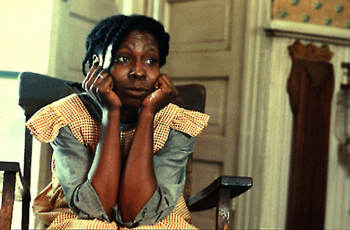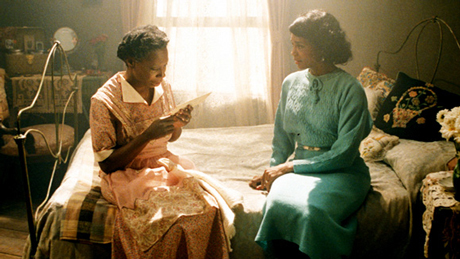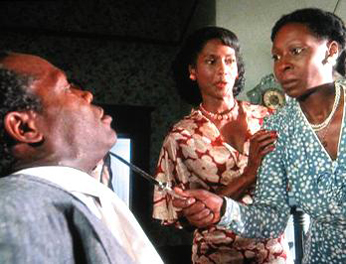
 |
|
|
|
Steven Spielberg's film career in the 1980s was a rising arc of commercial accomplishment and growing critical resentment. The director only stumbled once, with 1941, a critical flop that should be considered a "teething" film by a director showing the studios that he could not be controlled. Spielberg found himself being sniped at by critics complaining that the phenomenally popular movies he and George Lucas were making had wiped out the mini-Golden Age of the 1970s, when directors finally took full command to make personal, artistic pictures. Whether their films were good or bad, the Rafelsons and Michael Richies and even the Martin Scorseses couldn't touch the stratospheric box office performances of Spielberg's big summer blockbusters, and the industry followed the money. Spielberg's string of successes continued to snowball through more record-breakers and a TV series, until his career once again found a new direction: he made a concerted effort to become a "serious" film director, the kind who wins Oscars, funds film schools and build monuments of marble. Spielberg found that his audience responded best to warm films about families. E.T. was so warm and fuzzy that its eraserhead alien might have well been Lassie, shaved bald: it's about families, dummy. Whether science fiction or horror or pirate adventure, the basis of the 80s Spielberg film was The Family. 
Spielberg's first film adapted from a best-selling novel about family woes is 1985's The Color Purple. He gives the material a cinematic workout as might David O. Selznick, leaving not one scene nor one shot free of his complete artistic attention. The long and episodic novel by Alice Walker was adapted into a long and episodic screenplay by Menno Mayjes. A fascinating and eye-opening story of rural Georgia blacks in the first half of the 20th century, The Color Purple compresses a lot of soap-opera dramatics into its 154 minutes. If wringing tears is a good measure of filmmaking, it earns an A+. Poor sisters Celie and Nettie are subjected to frequent rapes by their own father; Celie bears two children that her father takes away from her. He doesn't want to let the more attractive Nettie go, but allows local farmer Albert Johnson (Danny Glover) to take Celie as his child bride. Celie knows her husband only as "Mister". His idea of family life is to force Celie to wait on him and his rotten kids from a previous marriage, and submit to more non-consensual marital sex. Nettie's extended visits bring Celie much joy, but the sister is thrown out when she refuses Mister's advances. When Nettie sends letters Mister refuses Celie mailbox privileges, and hides them. Celie (as an adult, Whoopie Goldberg) continues to serve her pitiless Mister. When Mister's son Harpo (Willard Pugh) brings home Sofia, his bride of choice (Oprah Winfrey), Mister doesn't like her dominating ways and breaks up the marriage. Mister then brings his long-time lover Shug Avery (Margaret Avery) home to recover from an alcoholic spell. Shug and Celie get along very well, and Celie is encouraged to start thinking of her situation as better than hopeless. Years pass as various tribulations, humiliations and tragedies befall Celie's friends and relatives, but she never gives up hope that she'll see Nettie again. As indicated (not hinted, not suggested) by its references to Oliver Twist, The Color Purple is a tale of injustice and misery on an epic scale. Poor Celie has no recourse but to submit to cruel brutalities from her lout of a husband. Everybody considers her a doormat, including her new kids. The sexy blues singer Shug is also dismissive at first, but soon begins to appreciate Celie. So does the aggressive Sofia, in her own way. Most of the positive characters in The Color Purple are black women, who have little choice but to accept the abuse of monster father-rapists and monster husband-rapists. Shug has been liberated by her attractiveness and talent but harbors a private sorrow of her own: "my father respects me but he doesn't know it". The women of The Color Purple are strong and vital. If anything, the story appears to chart the evolution of the black American family from a patriarchal terror state modeled after the experience of slavery to a coming generation where the women are increasingly in charge. 
Thus The Color Purple shapes up as an ultimate Saga of Black America, that also happens to be an ultimate Politically Correct saga. Racial oppression is a given, so much so that the acceptance of gross injustice is the only proper response. Poor Sofia pays dearly when she expresses her pride against a white insult, losing eight years, her children, her looks and some of her personality. The sisterhood is everything. It's attuned to life and family happiness and positive values, as opposed to the horrors of the Mister dictatorship. The sisterhood even accepts same-sex relations, in response to Celie's extreme need to experience passion as something positive. On the other hand, most of the men are ignorant brutes or fools. The selfish Albert Johnson doesn't understand himself and can only feel important by dominating helpless women. His father is from the same jerk stock, only older. Son Harpo is depicted as a bozo; the screenwriter uses him as a comic patsy, forever taking silly falls like a silent movie clown. Harpo eventually redeems himself by the only means possible, behaving decently to his wife. The film is best when Spielberg lets his actors get on with it. Either they're uniformly brilliant or Spielberg is terrific with actors or editor Michael Kahn knows just how to tweak performances in his cutting. The emotions are expressed well and the story is often very affecting. But the movie is over-directed. When Spielberg brings out his toy box, we see an unending parade of "directorial touches" -- crane shots, diving into the mailbox shots, grandiose camera trucks with marching groups of people. The film has no appreciation of what destitute misery can be -- even Harpo's broken-down shacks look like something wonderful from Tom Sawyer's Island. There's never a day in Georgia that isn't drop-dead gorgeous, even when it's raining or a storm is brewing; everybody looks well fed, if not downright prosperous. The movie is designed within an inch of its life, and cinematographer Allen Daviau drowns the screen with pretty pictures that warp the world of poverty the film aims to depict. Those purple flowers in the fields keep coming back to provide postcard images for major emotional farewells and reunions. To some degree, Alex Cox is correct: Spielberg too often blurs the line between director and confectioner. Spielberg would make some unwatchable pictures like Always and Hook but also a couple of near masterpieces. Unfortunately, even the good movies are marred with scenes that just poke the audience once too often, shoving sheer baloney in our faces. The scenes usually involve some kind of spiritual epiphany or character breakthrough, the kind of scene we admire in old movies. Even John Ford could try too hard, but when he hit the right emotional note with his potent visuals, our hearts caught in our throat. Spielberg tries for these "big moments" far too often, as if begging to be acknowledged as a great director: the fighter planes flying by the towers in Empire of the Sun, the "I could have saved more" speech from the otherwise admirable Schindler's List, Leonardo DiCaprio staring in a picture window at a happy family in Catch Me If You Can. In each case, a movie that's made most of the right moves suddenly goes sour, as if Spielberg fears that somebody in the back row isn't going to realize how talented he is, and needs to be clobbered over the head. 
In The Color Purple, a party at Harpo's Jook Joint is interrupted by the sound of a gospel choir over at the church. Shug becomes inspired (make that, Inspired!) to lead a parade of friends and jazz fans in their best struttin' threads down the road toward the church. The gospel singers hear Shug's voice carrying the lead from outside -- her group bursts through the church doors. Shug parades halfway to the altar, to meet up with the formerly disapproving preacher. And a big character climax comes in tears and cheers, in a manner so public as to put Frank Capra to shame. The scene panders to the audience something terrible. A good character has been used to fashion a pre-fab Classic Moment. It's fake, false, bogus and worse; it reminds us of kitschy moments in Green Pastures or Finian's Rainbow: what's next, Leprechauns? The Color Purple is too good to be derailed by this scene, but you just have to wonder. Fortunately, we remember the excellent performance of Whoopi Goldberg, who has never done anything as remotely interesting since. Her investment in her role is matched by Danny Glover and the remarkable Oprah Winfrey, who would return to acting work now and then while re-inventing herself and building her media empire. Margaret Avery had more experience than either of her female co-stars and shines as the bigger-than-life Shug. Rae Dawn Chong, Adolph Caesar and Lawrence Fishburne have smaller parts, but make good impressions. Warner Home Video's Blu-ray of The Color Purple puts all previous video versions to shame, and also looks better than the scratched new print I saw projected back in 1986 or so. Spielberg has made some candy-colored pictures but Allen Daviau's images seek out rich earth tones and amber light from setting suns. The photography unifies Spielberg's strained "letters from Africa" montage, with its trite parallelisms (water drops becoming native musical instruments) and weak surprises (an elephant in your lap!). One thing that Spielberg never gets wrong is his choice of lenses, and the bulk of The Color Purple's dialogue scenes are smoothly, effortlessly blocked and directed. 
The disc contains a full roster of featurettes slanted toward the film's relevance to the experience of black Americans, as was the miniseries Roots a few years earlier. The titles are: Conversations with Ancestors: From Book to Screen; A Collaboration of Spirits: Casting and Acting; The Musical Cultivating a Classic (Making Of). Other gallery extras discuss the actors and their roles, and the theatrical trailers are included as well. The packaging is Warners' fancy book package, with a forty-page souvenir booklet containing plenty of color photos. Back in 1986, The Color Purple was overshadowed by a small ruckus at the Oscars. It was nominated for eleven Academy Awards but not for Steven Spielberg's direction. This apparent snub was compounded when the film took home absolutely nothing on Oscar night. Whether the Academy thought the competition better or resented Spielberg's success is unclear. In my estimation the big winner Out of Africa was a bloated bore, but the other Best Picture nominees weren't all that hot either. Best actress Geraldine Page (The Trip to Bountiful) was a deserving winner, as was Anjelica Huston (Prizzi's Honor). Most of the technical awards chased Africa, as is the usual practice. For several years thereafter, Hollywood flacks spread stories of the town's reluctance to give Spielberg top awards. I think he started winning when his pictures began to shake off their artifice and he embraced subjects closer to his own experience. Or maybe the backlash was because Spielberg seemed courted Oscar recognition too strongly, as John Wayne had done with his bloated The Alamo. The Academy can be very fickle about that. But who knows? If anything, Spielberg can take heart in the fact that some of the film student heroes he most admired -- Howard Hawks, Alfred Hitchcock -- were given awards much less frequently than one might expect. Hitchcock was nominated five times for best director, and two of those were for films unsurpassed anywhere by anybody. Yet he never took home a statuette.
On a scale of Excellent, Good, Fair, and Poor,
The Color Purple Blu-ray rates:
Reviews on the Savant main site have additional credits information and are often updated and annotated with reader input and graphics. Also, don't forget the 2010 Savant Wish List. T'was Ever Thus.
Review Staff | About DVD Talk | Newsletter Subscribe | Join DVD Talk Forum |
| ||||||||||||||||||